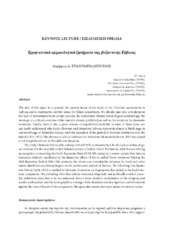| dc.description.abstract | Τhe aim of this paper is to present the current status of the study of the Christian monuments in Euboea and to summarize current issues for future researchers. We should take into consideration the lack of monuments from certain periods, the sometimes obscure chronological terminology, the shortage of a critical overview of the material already published, as well as the tendency for damnatio memoriae. Finally, there is also a great volume of unpublished material. In view of these facts, one can easily understand why Early Christian and Byzantine Euboea represents almost a blank page in our knowledge of Byzantine Greece, with the exception of the period of Venetian dominion over the island (1204-1470). The absence of a local Ephorate for Byzantine Monuments before 2005 has played a not-insignificant role in this defective situation. The Early Christian Period (4th century AD-AD 565) is characterized by the lack of archaeological evidence for the majority of its Christian centres (Chalkis, Oreoi, Porthmos), with Karystos being an exception. Concerning the Early Byzantine Period (7th-9th century), it seems certain that Euboea remained relatively unaffected by the disastrous effects of the so-called ‘Slavic invasions’. During the Mid-Byzantine Period (9th-12th century), the island was considerably favoured by local and other saints, which had an obvious impact on the architecture and art of Euboea. The following Late Byzantine Period (1204-1470) is marked by the Latin Dominion on Negroponte that ended to the fatal Ottoman occupation. The prevailing view that Euboea remained religiously and politically a rather peaceful, indifferent place has to be reconsidered, since a more detailed examination of the religious and secular architecture and the iconographical settings of the churches reveal a vigorous confessionalism against the Latin Church of the conquerors. The appendix enumerates open issues on various topics. | nob |
